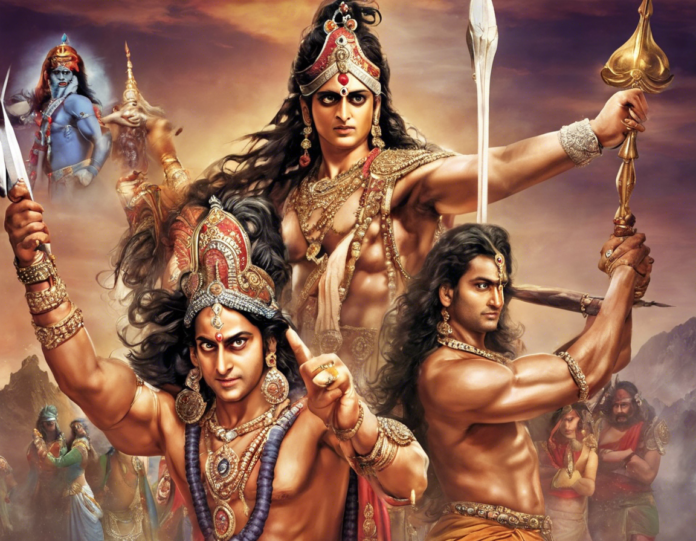The epic Sanskrit text of the "Mahabharata" is one of the longest and oldest Indian epic poems, consisting of over 200,000 verses. It is a rich tapestry of stories, mythology, philosophy, and moral teachings. The Mahabharata is not just a mythological tale but a comprehensive guide to life, with its lessons and teachings still relevant in today's world. In this guide, we will explore the complete Mahabharat episode guide, delving into the various chapters and highlighting the key events, themes, and lessons that can be learned from this timeless epic.
Introduction to the Mahabharata
The Mahabharata is divided into 18 books, known as Parvas, which are further subdivided into chapters. The central story revolves around the rivalry between the Pandavas and the Kauravas, two branches of the royal family of the Kuru dynasty. The struggle for power, the complexities of dharma (duty/righteousness), and the concept of karma (actions and their consequences) are some of the central themes of the epic.
Key Characters
- Pandavas: Yudhishthira, Bhima, Arjuna, Nakula, and Sahadeva, the five righteous and virtuous brothers who are the heroes of the epic.
- Kauravas: Duryodhana, Dushasana, and the hundred Kaurava brothers who oppose the Pandavas.
- Krishna: The divine incarnation who serves as Arjuna's charioteer and guide.
- Draupadi: The brave and outspoken wife of the Pandavas, who plays a central role in the epic.
- Bhishma: The grand patriarch of the Kuru dynasty, known for his vow of celibacy and loyalty to the throne.
- Karna: The tragic hero, born to Kunti before her marriage, who becomes a key figure in the Kurukshetra war.
Mahabharata Episode Guide
-
Adi Parva: The origins of the Kuru dynasty, the birth of the Pandavas and the Kauravas, and the game of dice that leads to the Pandavas' exile.
-
Sabha Parva: The Pandavas' years in exile, the humiliation of Draupadi in the court of Hastinapura, and the events leading up to the Kurukshetra war.
-
Vanaparva: The Pandavas' adventures in the forest during their exile, including encounters with sages, demons, and various gods.
-
Virata Parva: The Pandavas' year in disguise at the court of King Virata, where they prepare for the final battle.
-
Udyoga Parva: The negotiations, alliances, and preparations for war on both sides, with Krishna serving as a mediator.
-
Bhishma Parva: The first ten days of the great Kurukshetra war, with Bhishma serving as the commander of the Kaurava army.
-
Drona Parva: The war continues with Drona leading the Kaurava army, and key battles such as the death of Abhimanyu.
-
Karna Parva: The tragic end of Karna, the revelation of his true identity, and his battle with Arjuna.
-
Shalya Parva: The final days of the war, culminating in the death of Duryodhana and the ultimate victory of the Pandavas.
-
Sauptika Parva: The night raids and treachery that lead to the deaths of many warriors, including Drona and Karna.
-
Stri Parva: The aftermath of the war, the lamentations of the women who have lost their loved ones, and the crowning of Yudhishthira as king.
-
Shanti Parva: The teachings of Bhishma on kingship, dharma, and righteousness, as well as the rules of governance for a just society.
-
Anushasana Parva: The final instructions of Krishna to Yudhishthira on how to rule wisely and compassionately.
-
Ashvamedhika Parva: The horse sacrifice conducted by Yudhishthira to establish his supremacy as a universal monarch.
-
Ashramavasika Parva: The retirement of the Pandavas to the forest, their renunciation of the world, and their eventual journey to heaven.
-
Mausalaparva: The great war fought among the Yadavas, which leads to the destruction of Krishna's clan.
-
Mahaprasthanika Parva: The journey of the Pandavas and Draupadi to the Himalayas, where they renounce their bodies one by one.
-
Svargarohanika Parva: Yudhishthira's journey to heaven and his final test of truthfulness before being reunited with his brothers and wife.
Themes and Lessons
- Dharma: The concept of duty and righteousness is a central theme of the Mahabharata, with characters constantly grappling with moral dilemmas and ethical choices.
- Karma: Actions and their consequences play a significant role in the unfolding of the epic, with characters facing the repercussions of their past deeds.
- Family and Relationships: The dynamics of familial relationships, loyalty, love, and betrayal are explored in depth, highlighting the complexities of human bonds.
- War and Peace: The futility of war, the devastation it brings, and the importance of pursuing peace and reconciliation are important lessons in the epic.
- Wisdom and Knowledge: The teachings of various sages, seers, and divine beings provide profound insights into life, death, and the nature of reality.
Frequently Asked Questions (FAQs)
-
Is the Mahabharata a true story?
The Mahabharata is a blend of myth, history, and religious teachings. While some events may have historical basis, the epic is primarily a spiritual and moral allegory. -
What is the Bhagavad Gita and where does it appear in the Mahabharata?
The Bhagavad Gita is a sacred Hindu scripture that appears in the Mahabharata, specifically in the Bhishma Parva of the epic. It is a dialogue between Lord Krishna and Arjuna on the battlefield of Kurukshetra. -
Who is the author of the Mahabharata?
The Mahabharata is traditionally attributed to the sage Vyasa, who is said to have composed the epic and recited it to the god Ganesha. -
What are some of the key teachings of the Mahabharata?
The Mahabharata imparts lessons on dharma, karma, righteousness, moral courage, the importance of family values, and the eternal struggle between good and evil. -
Why is the Mahabharata considered a timeless epic?
The Mahabharata's universal themes, complex characters, and profound philosophical teachings continue to resonate with readers across cultures and generations, making it a timeless classic. -
Are there any adaptations of the Mahabharata in popular culture?
The Mahabharata has been adapted into various formats, including TV series, films, plays, and novels. Some notable adaptations include the TV series "Mahabharat" and Peter Brook's theatrical production "The Mahabharata." -
What is the significance of the Kurukshetra war in the Mahabharata?
The Kurukshetra war symbolizes the eternal battle between righteousness and evil, with the Pandavas fighting to uphold dharma and establish justice in the kingdom. -
What role does Lord Krishna play in the Mahabharata?
Lord Krishna serves as a friend, philosopher, and guide to the Pandavas, providing them with moral support, strategic advice, and divine intervention when needed. -
How does the Mahabharata contribute to Indian culture and spirituality?
The Mahabharata is not just a literary masterpiece but a cultural and spiritual touchstone for Indians, offering profound insights into ethics, philosophy, and the eternal truths of life. -
What are some key takeaways for readers from the Mahabharata?
Readers can learn valuable lessons on duty, morality, loyalty, courage, forgiveness, and the pursuit of spiritual enlightenment from the timeless wisdom of the Mahabharata.
The Mahabharata stands as a monumental literary work that continues to capture the imagination and hearts of readers worldwide. Its timeless themes, rich characters, and profound teachings make it a literary treasure trove that offers something new with each reading. From the epic battles on the fields of Kurukshetra to the moral dilemmas faced by its characters, the Mahabharata remains a beacon of wisdom and inspiration for all who seek to unravel the mysteries of life and existence.

